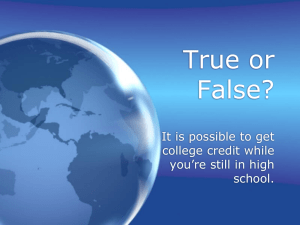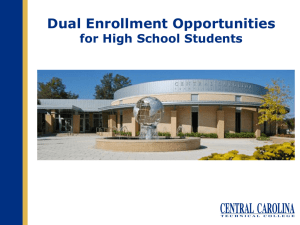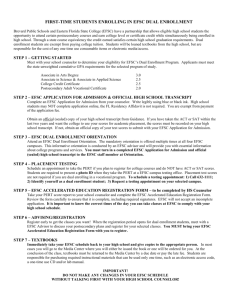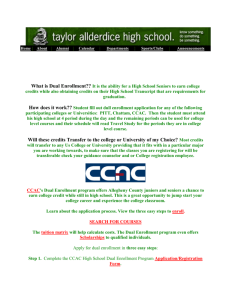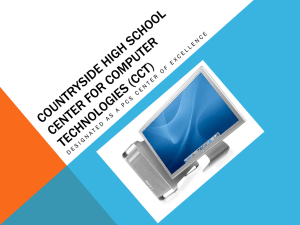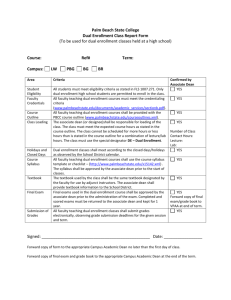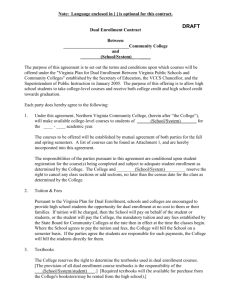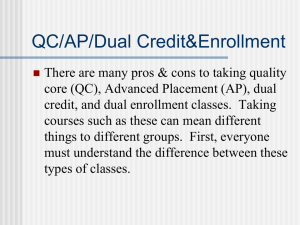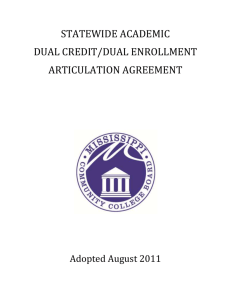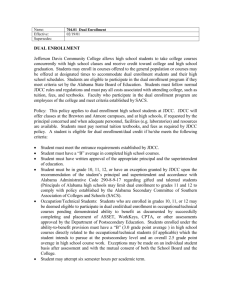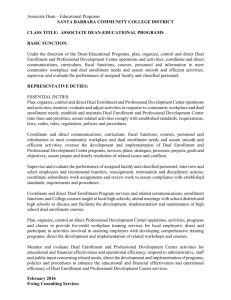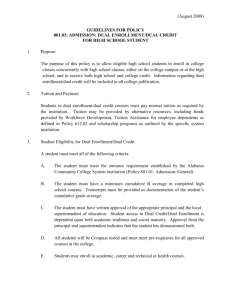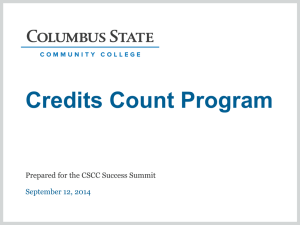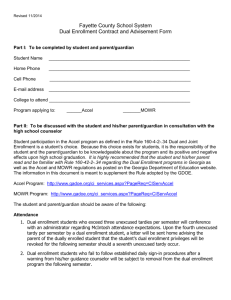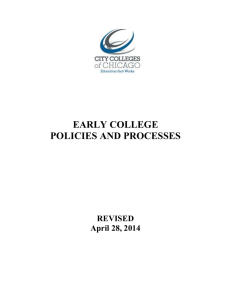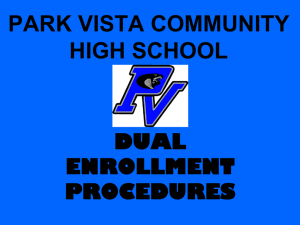Early College Access - Maryland State Department of Education
advertisement
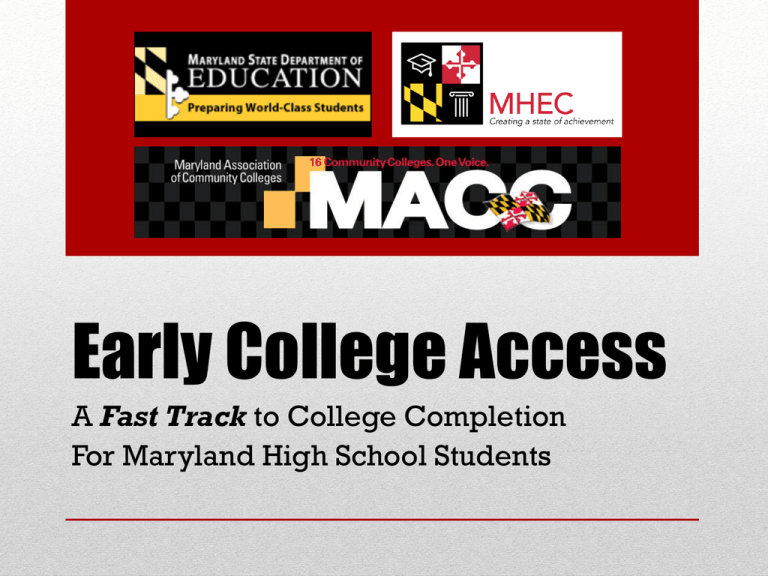
Early College Access A Fast Track to College Completion For Maryland High School Students “In late 2011, the Associated Press reported on census data revealing that nearly half of all Americans – a record number – either have fallen into poverty or have earnings that classify them as low-income.” Reclaiming the American Dream Community Colleges and the Nation’s Future A Report by the American Association of Community Colleges “The United States, which for generations led the world in degree completion, now ranks 16th in the world in completion rates for 25- to 34-year-olds.” Reclaiming the American Dream Community Colleges and the Nation’s Future A Report by the American Association of Community Colleges “By 2018, nearly two-thirds of all American jobs will require a postsecondary certificate or degree… “Between now and 2025, the United States will need to find an additional 15-20 million employees, as an aging and highly skilled workforce retires.” Reclaiming the American Dream Community Colleges and the Nation’s Future A Report by the American Association of Community Colleges Maryland’s economic future depends on post-secondary preparation… 77% of projected job openings in Maryland require some type of post-secondary training or education. Source: National Skills Coalitions’ analysis Maryland Department of Labor, Licensing and Regulation’s 2006-2016 Occupational Projections. NEW Challenges… and Opportunities K-12: Common Core Standards… Preparing every student for college and career readiness is now the true challenge. Higher Ed: Completion Agenda… Increased state and national emphasis on student success and degree completion. Why not tackle both NEW challenges with a proven strategy that has effectively served students for decades? Early College Access Stars… are aligning! Early College Access Why Early College Access? Benefits to K-12 and Higher Ed: Improving college readiness. Helping to conquer “senioritis.” Complementing AP course offerings. Increasing college completion rates. Closing the skills gap. Preparing underserved populations. Why Early College Access? Benefits to Students and Parents: Improvement in college readiness. Increased likelihood of college completion. Students gain portable college credits. Accelerated path to college degree or certificate. Significant savings in tuition costs. Average 2012 Community College Tuition $99 Per Credit Hour Average 2012 Public College Tuition $238 Per Credit Hour Average 2012 Md. Independent College Tuition $986 Per Credit Hour Cost-savings… Student Debt Reduction Early College Access Lowers Ultimate Tuition Costs, Reduces Student Debt Proven Model for Student Success At-risk students who participated in early college access, in California study, had better academic outcomes than similar, non-participating students… More likely to… Graduate from high school. Enroll in four-year colleges. Persist in college; accumulate more credits. Less likely to… Need remedial courses in college. Bridging College and Careers: Using Dual Enrollment to Enhance Career and Technical Pathways Community College Research Center, Columbia University Teachers College Three-year Study of Dual Enrollment Programs for At-risk Students in California (7-12) Study Finds Dual Enrollment Can Help Struggling College Students By Catherine Groux July 20, 2012 Today, many students in high schools across the country have the chance to take courses at a local community college while working toward their diplomas. Various academic professionals believe this can encourage these students to stay in college longer, giving them a better chance of earning an associate's or bachelor's degree. Study Shows Benefits of Dual Enrollment A recent three-year study by the Community College Research Center (CCRC) at Columbia University's Teachers College analyzed a dual enrollment program for at-risk students in California, including low-income youths, English learners and students who struggled academically. In monitoring participants of the dual enrollment program, researchers found that 62% of individuals in the first group went on to college, compared with only 48% of their peers. During the second year of the study, 51% of participants pursued postsecondary education, compared to 44% of their classmates. The study also found that when dual enrollment program participants enroll in college, they are more likely to persist than their peers. Additionally, they tend to accumulate a higher number of postsecondary credits than their classmates. Examining the Advantages of Dual Enrollment According to a June 2010 report by the Blackboard Institute, dual enrollment programs can provide many benefits to students. For instance, they give high schoolers the chance to see what college classes are like, which often provides them with confidence that they are ready for postsecondary education. What Does Early Access Look Like? Traditional dual/concurrent enrollment… High school students on college campuses. College courses taught at high schools. “Middle college” model; cohort of high school students on college campus. Early exposure to college life; not yet enrolled in coursework. Varied programs ranging from those for atrisk students to highest achievers. Access to online college courses. What Do Students Say… about Early College Access? On Easing the Transition… “I had taken AP classes, but I wanted to experiment with actual college-level courses. Taking classes at CCBC helped ease my anxiety about starting college.” - Megan Paice, Catonsville High School 2008, CCBC 2010, Towson University 2012 On Being Challenged… “We’re being challenged more than the normal classroom. We still get to have the social aspect of high school, but with the academics, we’re getting so much of an advantage.” - Toria Hawkins, attending Academy of Health Sciences at Prince George’s Community College (home to Maryland’s first middle college high school) On Saving Time and Money… “I was able to get the general education requirements for my later degrees completed so I could save money at the more expensive institutions.” - Mark Culver, Wicomico High School and Wor-Wic Community College, 2012, transferred to Salisbury University So What Next? A Call to Action… Increase opportunities for students to participate in early college access. Launch statewide awareness effort to highlight early college access programs, best practices in each school district. Ensure more uniform treatment of students in early college access programs around state. Publicly acknowledge interest in aligning college and career pathways through early college access (signing of statewide MOU; press release/press conference moment). Early College Access http://www.mdacc.org/colleges/early_college_access.html
